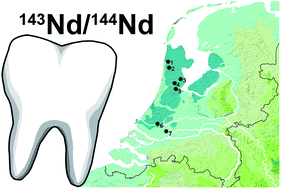TIMS analysis of neodymium isotopes in human tooth enamel using 1013 Ω amplifiers
Abstract
Human provenance studies employing isotope analysis are essential in archaeological and forensic sciences but current applications provide limited spatial resolution. This study reports on the potential of neodymium isotope composition (143Nd/144Nd) to improve human provenancing capabilities. Human tissues contain very low (<0.1 ppm) neodymium concentrations, such that previous composition analysis was not possible. Additionally, Nd composition analysis in human enamel is hindered by Ca in the sample matrix. A modified Nd chromatographic separation technique is reported here, which removes large Ca quantities and accommodates large sample sizes (300–1000 mg). Verification of the modified chromatographic procedure was achieved using an internal synthetic tooth standard. These advancements allow for high precision Nd isotope composition analysis on ∼500 mg of tooth enamel, or >100 pg of Nd, by thermal ionization mass spectrometry (TIMS) using 1013 Ω resistors. Neodymium concentrations in enamel from third molars of modern Dutch residents range between 0.1–21.0 ppb (n = 23). The 143Nd/144Nd values for Amsterdam (0.51204–0.51259, n = 12) and Rotterdam (0.51187–0.51239, n = 8) are significantly different (P value = 0.02), demonstrating the potential of neodymium isotope composition to provide improved spatial resolution. Further assessment of Nd composition in enamel of residents from other geological contexts is required to better understand the human provenance capabilities of neodymium.



 Please wait while we load your content...
Please wait while we load your content...